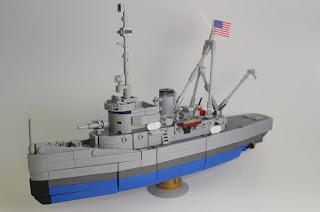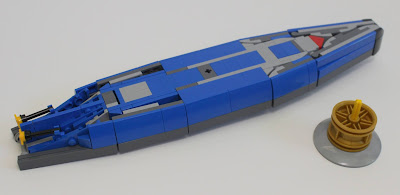USS Cherokee WWII fleet tug MOC
My newest MOC, the USS Cherokee (AT-66), a World War II Cherokee-class fleet tugboat. Inspired by an amazing model of the Cherokee by the designer Chuck, I took the details and techniques that I liked from his and put them into my build. Externally the two are very similar, bar the color scheme, however, the inside of my Cherokee is is much more over-engineered. Built to 1/200 scale with around 850 pieces, this amazing display model measures 32cm long, 7cm wide, and 21cm tall.
History
The tug remained in North African waters to care for the many ships concentrating there with men and supplies until 31 March 1943. Fitted with tanks, she served as a yard oiler at Casablanca until 3 May, when she departed for Norfolk. After overhaul, she reported at Bermuda 20 June 1943 to provide tug, towing, and salvage services to the escort vessels and submarines conducting training there.
Cherokee was reclassified fleet ocean tug ATF-66 on 15 May 1944. Twice in 1944 she crossed the Atlantic to Casablanca to take stricken destroyers in tow for the United States, carrying out these difficult assignments with distinguished seamanship. Upon her return from the second of these crossings in July 1944, Cherokee took up duty towing targets for ships in training in Casco Bay, Maine, until 28 May 1945, and at Guantanamo Bay, Cuba, until 23 July 1945. Following the war she continued towing operations in the Caribbean, along the east coast, and to Brazilian ports until she was decommissioned 29 June 1946 and transferred to the US Coast Guard that same day to become USCGC Cherokee (WAT-165). She was designated as medium endurance cutter WMEC-165 in 1965. She was later returned to the U.S. Navy, stricken in 1991, and sunk as a target later in the 1990s.
Model
Featuring accurate details and a few functions, this USS Cherokee MOC looks great on display. On her bow there is a 3-inch (76 mm) gun (which does swivel), along with the bridge. Many interesting techniques were used throughout the build, and some of my personal favorites, such as jumper plates for portholes and all the subtle curves and angles, are in the bow.
Amidships we find a small stack, lifeboats, ladders, Bofors anti-aircraft guns, and the red winch for the heavy-duty crane. Using a 5L thin Technic beam I was able to invert the build direction to attach the lifeboats and their accompanying cranes. You can also see a few of the hinges I used to curve the hull in the deck.
Towards the Cherokee's stern we have the moving crane arm for lifting and salvage operations, as well as a large assembly of bar pieces. This spiderweb of parts is actually part of the crane structure, it was used to provide a greater lifting capacity for the main crane arm. Of course, I couldn't resist recreating the Stars and Stripes flying from the top.
I also included a pearl gold stand that connects to the keel with a Technic axle (just wish I had a pearl gold 6x6 radar dish, though).














Comments
Post a Comment